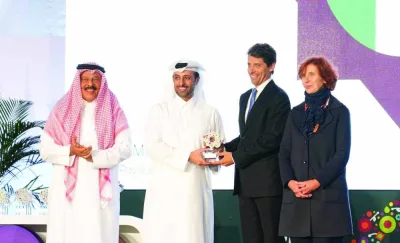An antidote to tales of golf’s demise, added to further examples of the sport working for a greater good, arrived once again from Arizona at the weekend.
The Waste Management Phoenix Open has not so much evolved as a tournament since moving to Scottsdale in 1987 as blasted into a fresh commercial stratosphere. The numbers attached to this event are quite staggering.
It has become self-fulfilling; this is one stop on the PGA Tour that spectators are desperate to play a part in. The tournament has been dubbed the “biggest party” in golf.
Attendance figures regularly reach half a million. Last week, almost 30,000 turned up for a Tuesday practice day; that figure rose to 58,000 on Wednesday, while the tournament’s first day proper had a crowd of 101,021 and Friday’s golf was watched by 160,415. Saturday? 201,000, reckoned to be the largest in the history of golf.
By the time Hideki Matsuyama had beaten a tearful Rickie Fowler in a play-off, an aggregate crowd of 618,365 had been recorded, beating the 2015 record of 564,368. Placed in some context, the elongated Open Championship at St Andrews last July pulled in 237,000.
Also in 2015, the Thunderbirds charity group – which distributes its share of income from the golf to needy causes – dished out $9m, which equated to all of the tournament’s profit.
That figure is sure to increase this time around. Thunderbirds Charities was established in 1986 with the sole aim of using money from the tournament to “assist children and families, help people in need and improve the quality of life in our communities” throughout Arizona.
The endearing news is that others are looking to take inspiration from an alluring PGA Tour stop, which was once little more than a tiny spot in the desert. Barry Funston, the chief executive of Rory McIlroy’s charity foundation, attended the Phoenix Open at the weekend with the specific intention of meeting with Thunderbirds and learning what has made the tournament such a success on all levels.
The link is straightforward; the Rory Foundation’s hosting of the Irish Open, as now sponsored by Dubai Duty Free, last year at Royal County Down saw fresh life breathed into an event which had earlier become worryingly stagnant.
McIlroy’s involvement should form part of his professional legacy; his ambitions to grow the tournament are obvious even in brief conversation.
There are now under 100 days until the K Club hosts the 2016 version. McIlroy, it is clear, wants the Irish Open to build on last year’s success. Taking notice of what happens in the providing of arguably the finest fan experience in golf makes perfect sense. The added connection, of course, comes by way of charity benefits.
“My commitment to making the Irish Open as successful as it can possibly be is well known,” McIlroy explained.
“If we can learn anything at all from such a huge event on the PGA Tour, that can only be a good thing. I was delighted the foundation was given the chance to learn more about what has made Phoenix so popular.
“Last year at Royal County Down was a massive success but that was just the start of my involvement in the tournament. Any opportunity we have to make it bigger and better, we will look to maximise.”
Two simple factors play a part in this booming Phoenix scenario. Firstly, the golf is brilliantly priced; free entry on Tuesday, $30 tickets on Wednesday and Thursday and $40 from Thursday onwards. Under-17s with adults can attend for free. Among those who should take note of fair, attractive cost is the R&A, which continues to charge like the Light Brigade for Opens.
The wider point is that what Phoenix hosts feels like a major event. For too long, and in too many places, those organising golf tournaments have believed the appearance of the sport’s biggest names in immaculate surroundings should be enough to thrill the masses.
This constitutes laziness, if not negligence. It represents an antiquated business model; not only does golf have more competition than ever before for people’s time, money and attention, but those watching want more.
They want to feel a part of something special and to engage; one glance at the amphitheatre 16th hole at Scottsdale, one of the most memorable golfing spots in the world now during tournament week, sets the Phoenix Open apart. Some 15,000 fans are routinely crammed around that one hole, plus extensive corporate boxes which are greatly sought after by blue-chip companies.
That exact scene probably can’t be replicated elsewhere but it is an annual example of what happens when the public imagination is captivated, as assisted by golfers who clearly revel in the atmosphere.
Tiger Woods’s hole-in-one at the 16th, back in 1997, remains a marquee moment and one which undoubtedly played its own part in catapulting the tournament narrative.
Golf has sufficient stories of woe for the positives to be accentuated when they arrive. Phoenix is the latter; a wonderful tale of making the sport in competitive form work. It should be hailed as thus.
If Ireland – plus the European Tour – soon earns a spin-off, a nod is due towards effective research and planning.

Rickie Fowler lines up a putt on the second playoff hole during the final round of the Waste Management Phoenix Open at TPC Scottsdale in Scottsdale, Arizona. (Getty Images/AFP)

